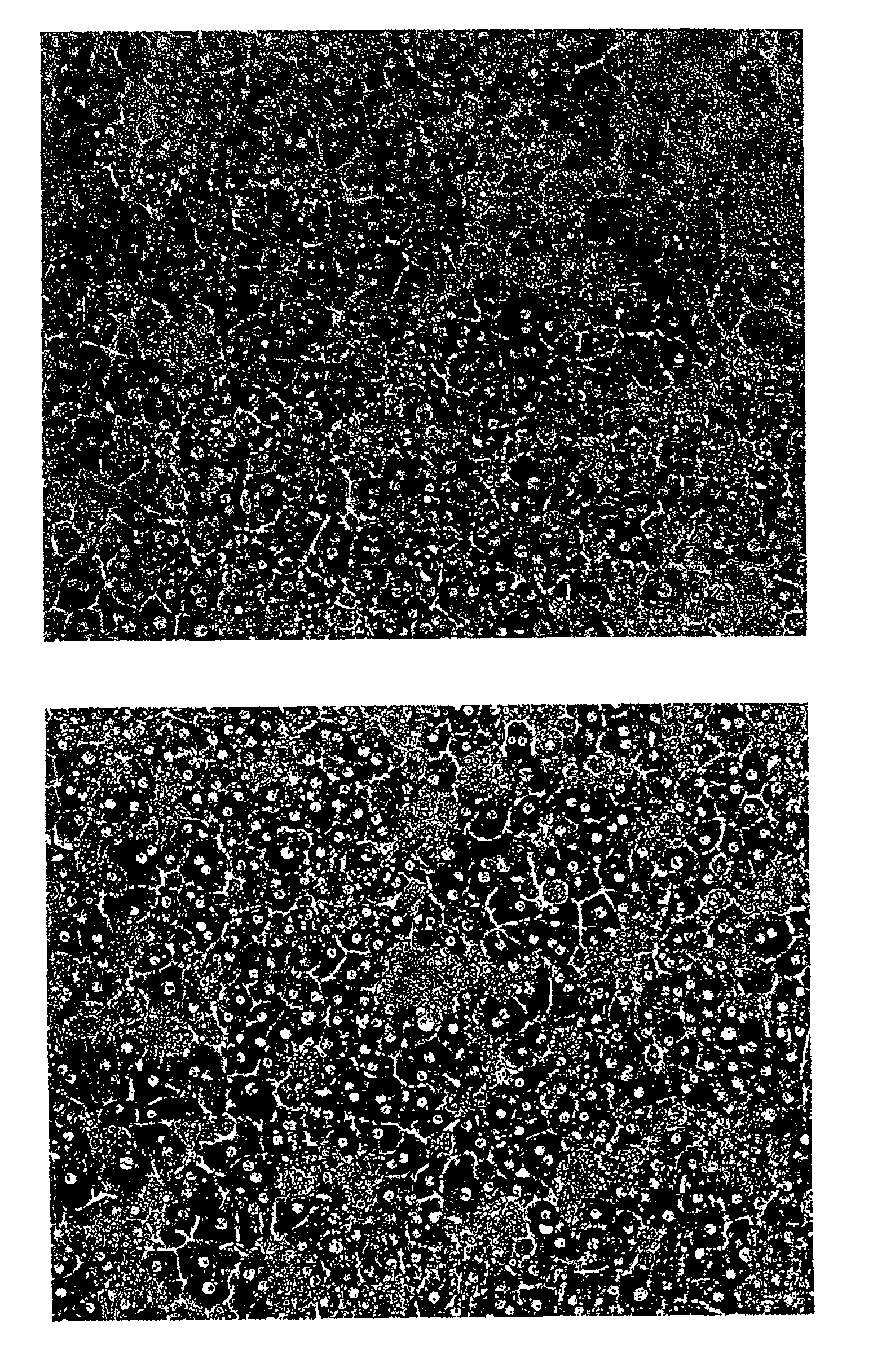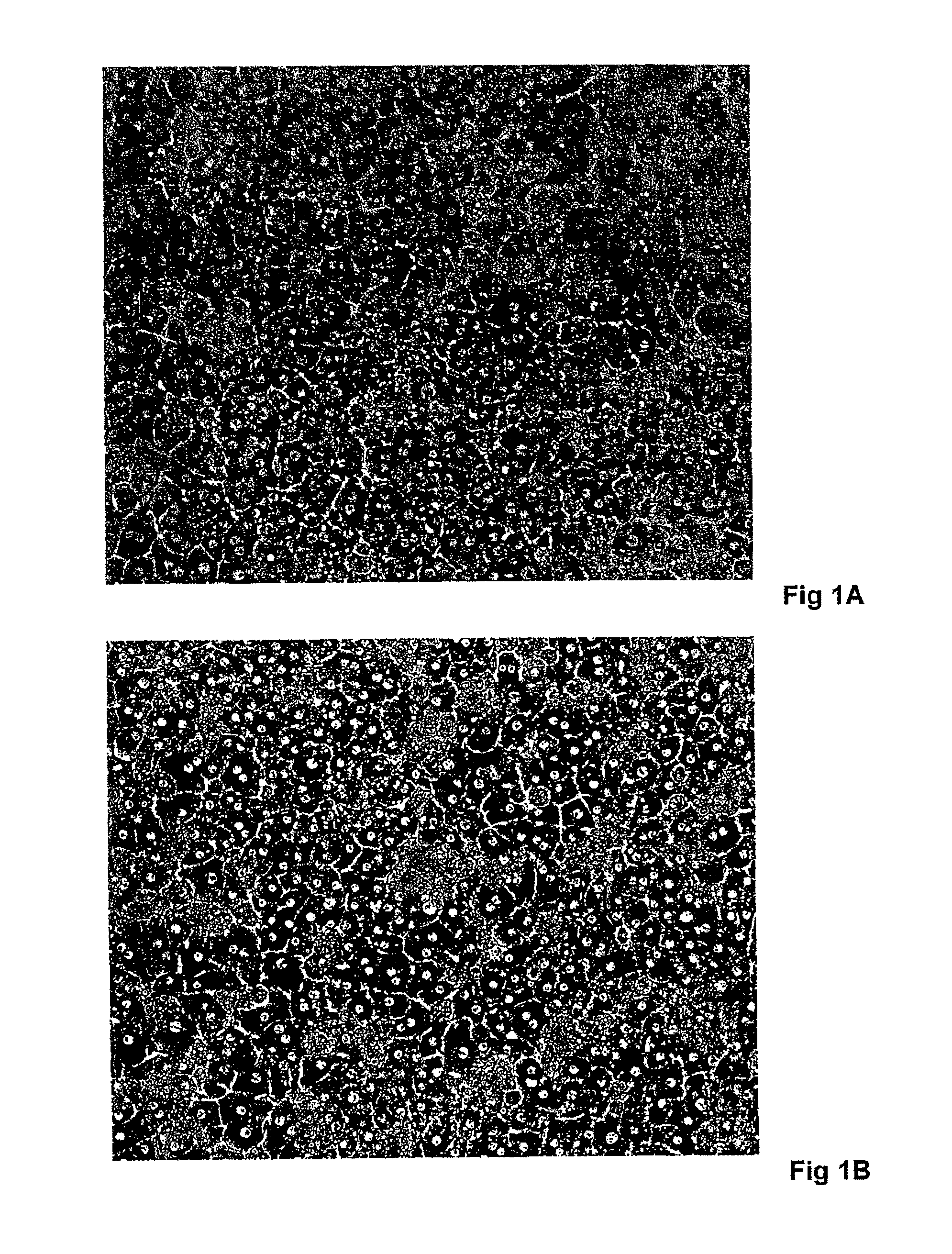Cryopreservation of Hepatocytes
a technology for hepatocytes and cryopreservation, which is applied in the field of cryopreservation of hepatocytes, can solve the problems of inability to predict whether freshly isolated human hepatocytes are available regularly and at any time, and cannot be used in thawed cultures, which contain a high proportion of non-vital cells and cell debris
- Summary
- Abstract
- Description
- Claims
- Application Information
AI Technical Summary
Benefits of technology
Problems solved by technology
Method used
Image
Examples
example 1
Preparation of Human Hepatocytes for Cryopreservation
1.1 Isolation of Human Hepatocytes
[0039]Hepatocytes from human donors were isolated in a manner known per se from tissue parts anyway removed surgically, which were taken with the agreement of the donor. For this, the tissue was perfused, the hepatocytes detaching from the tissue complex and being able to be obtained from the perfusion solution. The viability of the harvested hepatocytes was determined by means of Trypan Blue assay. For the further experiments, only cell preparations were used which showed more than 70% Trypan Blue exclusion.
1.2 Preparation of a Matrix
[0040]In the following experiments, cell culture vessels in the form of multiwell plates, 6-well plates (type 657 160, Greiner Bio-One) were used. The plates were coated with native collagen gel, which was preferably isolated from rat tails. Alternatively, multiwell plates, 6-well plates, precoated with collagen type 1 (type 657 950 CELLCOAT, Greiner Bio-One) were us...
example 2
Thawing of Cryopreserved Hepatocytes
[0049]The hepatocyte cultures frozen according to Example 1 and stored at −151° C. were thawed and recultured for further use in in vitro tests after a storage period of up to 4 weeks. For the thawing of the cryopreserved hepatocyte cultures, the 6-well plates were first transferred for 5 minutes to a culture cabinet, which was operated using standard conditions, immediately after taking from the freezer or nitrogen tank (see Example 1). Subsequently, 1 ml of medium 1 per well prewarmed to 37° C. (see Example 1) was added slowly and dropwise to each well. This process was repeated for at most three simultaneously thawing 6-well plates, that is for at most 18 wells.
[0050]Subsequently, the process was repeated, again in each case 1 ml of medium 1 being slowly added per well. The supernatant was then aspirated with a Pasteur pipette. The supernatant essentially contained thawed nonvital and nonadherent cells.
[0051]For further washing, in the same way...
example 3
Determination of the Number of Viable Cells
[0055]The number of viable (vital) cells was determined in cultures of freshly isolated hepatocytes and in cultures of cryopreserved hepatocytes according to the invention by counting the morphologically intact cells. Here, photographs of comparison areas of a size of 0.259 mm2 were counted. From the number of the intact cells found in the comparison area, the number of intact cells in the entire cell culture vessel was concluded (for the 6-well plates used having an area of 9.6 cm2 per well, a correction factor of 3700 resulted).
[0056]Before freezing and at various points in time after thawing after cryopreservation, the morphology of the recultured hepatocytes was documented photographically and compared with cultures of freshly isolated and cultured hepatocytes.
Results:
[0057]FIG. 1 shows the morphology of human hepatocytes which were freshly isolated and inoculated on a collagen gel layer (FIG. 1A) and the morphology of isolated human he...
PUM
| Property | Measurement | Unit |
|---|---|---|
| temperatures | aaaaa | aaaaa |
| area | aaaaa | aaaaa |
| time | aaaaa | aaaaa |
Abstract
Description
Claims
Application Information
 Login to View More
Login to View More - R&D
- Intellectual Property
- Life Sciences
- Materials
- Tech Scout
- Unparalleled Data Quality
- Higher Quality Content
- 60% Fewer Hallucinations
Browse by: Latest US Patents, China's latest patents, Technical Efficacy Thesaurus, Application Domain, Technology Topic, Popular Technical Reports.
© 2025 PatSnap. All rights reserved.Legal|Privacy policy|Modern Slavery Act Transparency Statement|Sitemap|About US| Contact US: help@patsnap.com



